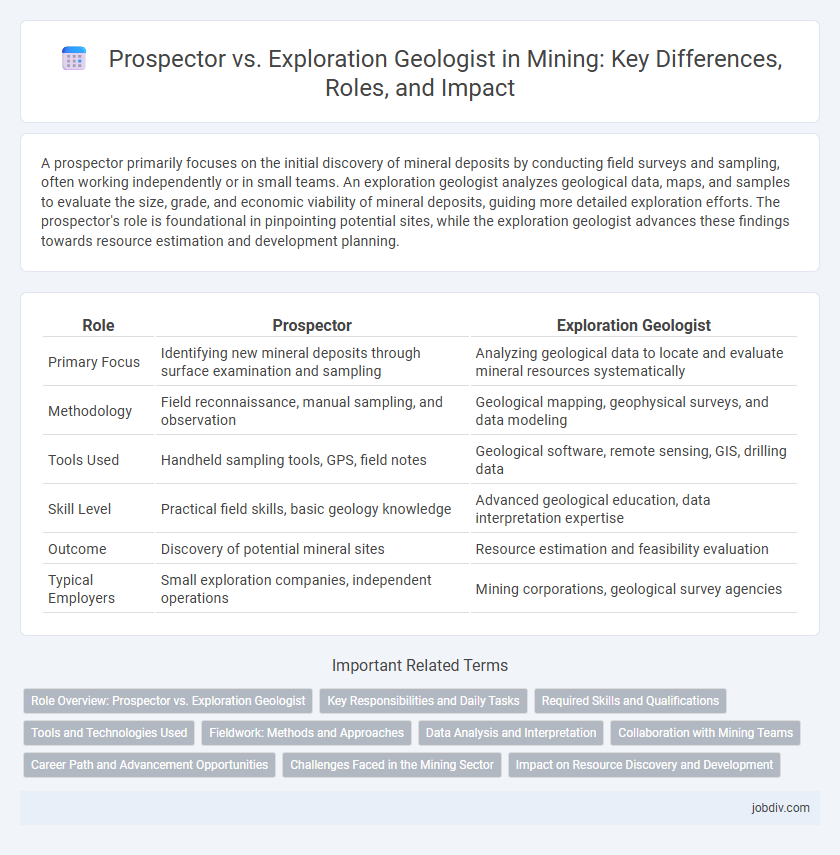A prospector primarily focuses on the initial discovery of mineral deposits by conducting field surveys and sampling, often working independently or in small teams. An exploration geologist analyzes geological data, maps, and samples to evaluate the size, grade, and economic viability of mineral deposits, guiding more detailed exploration efforts. The prospector's role is foundational in pinpointing potential sites, while the exploration geologist advances these findings towards resource estimation and development planning.
Table of Comparison
| Role | Prospector | Exploration Geologist |
|---|---|---|
| Primary Focus | Identifying new mineral deposits through surface examination and sampling | Analyzing geological data to locate and evaluate mineral resources systematically |
| Methodology | Field reconnaissance, manual sampling, and observation | Geological mapping, geophysical surveys, and data modeling |
| Tools Used | Handheld sampling tools, GPS, field notes | Geological software, remote sensing, GIS, drilling data |
| Skill Level | Practical field skills, basic geology knowledge | Advanced geological education, data interpretation expertise |
| Outcome | Discovery of potential mineral sites | Resource estimation and feasibility evaluation |
| Typical Employers | Small exploration companies, independent operations | Mining corporations, geological survey agencies |
Role Overview: Prospector vs. Exploration Geologist
Prospectors primarily focus on identifying mineral deposits through surface-level searches, sample collection, and preliminary evaluations of potential mining sites. Exploration geologists conduct detailed subsurface investigations using geological mapping, geophysical surveys, and drilling data to assess the size, grade, and economic viability of mineral deposits. Both roles collaborate to transform initial discoveries into viable mining projects, with prospectors initiating exploration and exploration geologists guiding advanced resource assessments.
Key Responsibilities and Daily Tasks
Prospectors primarily focus on identifying and locating mineral deposits through fieldwork, sampling, and geological mapping, often in remote or undeveloped areas. Exploration geologists analyze collected data, conduct detailed surveys, and develop models of ore bodies to guide drilling programs and resource estimation. Their daily tasks include rock and soil sampling, geophysical data interpretation, drilling supervision, and coordinating with mining engineers to evaluate resource viability.
Required Skills and Qualifications
Prospectors typically require strong skills in field mapping, mineral identification, and physical stamina, often holding certifications in mineral exploration or geology-related disciplines. Exploration Geologists need advanced qualifications, such as a bachelor's or master's degree in geology or earth sciences, with expertise in geophysical data interpretation, geochemical analysis, and experience using GIS and remote sensing technology. Both roles benefit from knowledge of mining regulations, safety protocols, and proficiency in data reporting and communication within multidisciplinary teams.
Tools and Technologies Used
Prospectors primarily use handheld tools such as metal detectors, GPS devices, and portable rock hammers to identify mineral-rich sites, emphasizing surface-level investigation. Exploration geologists employ advanced technologies including geological mapping software, 3D seismic imaging, airborne geophysical surveys, and geochemical analysis to assess subsurface mineral deposits and evaluate resource potential. Both roles integrate digital data collection and remote sensing techniques, but exploration geologists rely more heavily on complex analytical tools for detailed site modeling and resource estimation.
Fieldwork: Methods and Approaches
Prospectors primarily focus on surface observations and quick sampling techniques such as panning, trenching, and grab sampling to identify potential mineral deposits. Exploration geologists employ a more systematic and scientific approach, utilizing detailed mapping, geophysical surveys, and drilling to collect subsurface data. Both rely on fieldwork but exploration geologists integrate laboratory analyses and geochemical data for a comprehensive assessment of mineral resources.
Data Analysis and Interpretation
Prospectors primarily focus on initial data collection through field observations, sampling, and basic geological mapping to identify potential mineral deposits. Exploration geologists advance this process by conducting in-depth data analysis using geochemical assays, geophysical surveys, and geological modeling to interpret subsurface structures. Their expertise in synthesizing diverse datasets enhances the accuracy of resource estimation and guides drilling programs effectively.
Collaboration with Mining Teams
Prospectors and exploration geologists collaborate closely with mining teams to enhance resource identification and extraction strategies. Prospectors provide valuable field insights and target generation, while exploration geologists contribute detailed mapping, sampling, and analysis to validate deposits. This synergy improves decision-making efficiency, reduces exploration risks, and accelerates the transition from discovery to development within mining projects.
Career Path and Advancement Opportunities
Prospectors primarily focus on identifying mineral deposits through fieldwork and sample collection, often requiring less formal education and offering entry-level access to the mining industry. Exploration geologists typically possess advanced degrees in geology or related fields and engage in detailed analysis, mapping, and resource estimation, enabling faster career advancement into senior technical or management roles. Career paths for exploration geologists often include progression to project manager, chief geologist, or exploration director, whereas prospectors may transition into technical positions through experience and additional qualifications.
Challenges Faced in the Mining Sector
Prospectors frequently encounter difficulties such as locating viable mineral deposits in remote, rugged terrains with minimal data, facing significant risks in initial discovery phases. Exploration geologists tackle challenges involving comprehensive data analysis, integrating geophysical, geochemical, and geological information to accurately model ore bodies, often under strict environmental and regulatory constraints. Both roles demand adapting to unpredictable geological conditions and evolving technological tools to improve mineral resource identification and extraction efficiency.
Impact on Resource Discovery and Development
Prospectors play a critical role in initial resource discovery by identifying mineral deposits through surface sampling and geological mapping, which guides the targeting of exploration efforts. Exploration geologists analyze subsurface data using geophysical and geochemical methods to delineate ore bodies, assess resource potential, and design drilling programs essential for resource development. The collaboration between prospectors and exploration geologists accelerates the transition from discovery to resource estimation, directly impacting the efficiency and success of mining projects.
Prospector vs Exploration Geologist Infographic

 jobdiv.com
jobdiv.com